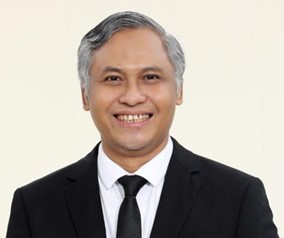
Indonesia has been an innovator in financing its large sovereign Sukuk in 2021, with the dimension of the green Sukuk, an Islamic bond designed to finance green investments, and has recently issued its first SDG bond. We profile HE Suminto Sastrosuwito, Director General of Budget Financing and Risk Management at Indonesia’s Ministry of Finance and get his views on his role in financing and how Indonesia plans to finance the energy transition.
How do you view the role of the Ministry of Finance of the Republic of Indonesia in supporting Indonesia’s agenda on the energy transition?
Suminto Sastrosuwito: The energy transition is vital, given that the world is currently dealing with the consequences of climate change. It is also critical for Indonesia given that 90% of the country’s energy sector remains reliant on fossil energy, which is one of the main contributors to greenhouse gas emissions. Indonesia has considerable resources of renewable energy, more than 3,000 GW, comprising solar, hydro, wind, bioenergy, ocean, and geothermal.
The Government of Indonesia has a strong commitment to tackling climate change and achieving Sustainable Development Goals (SDGs). In 2016, Indonesia ratified the Paris Agreement (through Law No. 16 of 2016). In the Nationally Determined Contribution (NDC), in order to prevent global warming of 2oC, the Government of Indonesia has pledged to reduce emissions by 29% under its own efforts (business as usual) and by 41%, with international support, by 2030. In 2022, according to our latest Enhanced Nationally Determined Contribution (NDC) document, Indonesia has committed to increasing its targets to reduce greenhouse gas (GHG) emissions. The target has increased from 29% to 31.9% [by the country’s own efforts alone] and from 41% to 43.2% with international assistance by 2030.
The government even raised this target towards net zero emission (NZE) by 2060 or earlier in accordance with the Glasgow Climate Pact to limit global warming by 1.5oC. In particular, the energy sector, with a focus on the energy transition to new and renewable energy (NRE), is expected to reduce emissions by 358 million tons of CO2e with its own efforts and 446 million tons of CO2e with international support.
The target is quite ambitious and requires substantial financing, for which I believe the Ministry of Finance is playing a leading role in formulating a financing strategy. The commitment signifies the need for dedicated and long term financing, which is estimated to be worth at least 25% of Indonesia’s Gross Domestic Product (GDP), just to achieve the 2030 target. It is estimated that the government could only cover less than 30% of the financial needs through the state budget (APBN), while the private sector is expected to participate [to cover] 22% to 25% of capacity. Consequently, an additional 40%-55% of financing must be raised from other sources.
Therefore, the Government of Indonesia has issued a number of fiscal incentives or tax facilities to mobilise private investment in green projects and green industry, including tax holidays, tax allowances, as well as facilities on VAT, import duty, and property tax. In addition, the Government also provides facilities for green projects procured through the PPP scheme, such as the project development facility (PDF), the viability gap fund (VGF), and government guarantees.
We also develop innovative financing strategies through the optimisation of the state budget and mobilising funds from external sources. Various innovative financing instruments have been created to support the transition. The issuance of green Sukuk has been carried out since 2018 to fund the transition towards a low-carbon economy. Some Special Mission Vehicles (SMVs) have been established to mobilise and manage funds or develop sustainable projects, including the Indonesia Environment Fund (BPDLH), SDG Indonesia One (managed under PT SMI), and the Indonesia Investment Authority (INA).
We also encourage collaboration with development partners and optimising the role of SMVs, including PT SMI, IIGF, and Geo Dipa Energi, to contribute to the implementation of policies related to climate and energy transition. Furthermore, we coordinate with other core ministries and related institutions to ensure synergy and synchronisation of the climate policies taken by each institution. Lastly, we also actively promote these initiatives both in domestic and international forums to encourage collaboration and maximise opportunities to attract investment and financing from global communities and the private sector.
During Indonesia’s G20 Presidency, the government encouraged climate-related finance and sustainable infrastructure as being among the main agendas. Furthermore, as a concrete step forward in energy transition, in November 2022, during a side event of the G20 Forum, the Ministry of Finance proudly launched the Energy Transition Mechanism (ETM) Country Platform. The platform is aimed at mobilising international and private participation in financing ETM projects in a blended finance scheme.
Can you tell us about the path to success of the global Sukuk in 2021, particularly the green Sukuk? How are its proceeds being used?
Suminto Sastrosuwito: Indonesia has successfully raised over US$6.8 billion through multiple rounds of green Sukuk issuances in global and domestic markets. The proportion of green investors has also shown a trend increase, from 29% in the 2019 global green Sukuk to 33% and 57% in the 2020 and 2021 global green Sukuk issuances, respectively, and 36% in the 2022 global green Sukuk. These showcased how the global community is willing, if not committed, to take part in the green recovery movement. The shifting paradigm of investment towards a more sustainable preference has supported the green Sukuk market as a growing source of finance to address climate change even amid the pandemic. Hence, there is a remarkable momentum for public private financing of SDGs unfolding across the globe.
More governments are turning to public finance instruments to catalyse private investments for economic, social, and environmental goals. As a result, the number of thematic bonds and Sukuk (such as green, social, and sustainability bonds and Sukuk), and the size of the market, are growing, and green and responsible investors are getting more excited about the coming years.
Further to investing in projects reducing GHG emissions – projected to be up to 10.5 million tons of CO2e – proceeds from Indonesia’s green Sukuk have supported the construction of over 690 kilometres of railway tracks, an increase of 7.3 million kWh of electricity capacity, and improved solid waste management for more than 7.8 million households.
What are your plans for fundraising internationally in the Sukuk market in the future, particularly given international financial headwinds (and dollar strength) now? Do you plan to issue more SDG bonds?
Suminto Sastrosuwito: For Indonesia, international Sukuk issuance is intended to diversify the government’s financing instruments as well as broaden our investor base. It is not only part of our overall debt portfolio management strategy for achieving optimal cost and risk, but it also contributes to the growth of the Islamic financial market, specifically Sukuk.
We believe that as we head into 2023, the market backdrop will remain supportive for a new Indonesia Sukuk issuance. In line with this, we are confident that investors would be highly supportive given Indonesia’s strong credit profile and supportive supply and demand dynamics.
We expect the Sukuk industry to remain strong, given elevated oil prices and strong demand from Middle Eastern investors. Furthermore, given ample funding, GCC sovereign issuers are expected to issue fewer bonds next year.
As for the Sukuk structure, the current asset-light Wakala structure has already been widely accepted by Islamic investors globally and is aligned with the requirements of Islamic investors (including UAE investors, following the adoption of AAOIFI Shariah standards).
Indonesia is committed to tackling climate change issues through fund mobilisation, one of which is green Sukuk issuance.
As for thematic Sukuk, Indonesia has demonstrated thought leadership in pursuing Sukuk and green structures and unlocking liquidity in key investor hotspots such as the Middle East and Europe.
To further strengthen its leadership in green structure innovation, Indonesia will maintain its status among the world’s most sophisticated sovereign issuers through constant and consistent development in the thematic Sukuk markets.
What lessons can you share with other OIC Members planning to raise funding using Islamic finance (for instance, what have been the challenges and how have you managed to overcome them)?
Suminto Sastrosuwito: The enactment of Law No.19/2008 on Sovereign Shariah Securities, [namely Sukuk Negara] led to the government of Indonesia issuing IDR4.7 trillion in sovereign Ijarah Sukuk in that year alone. Since then, total issuance has now reached IDR1,919.77 trillion through various Sukuk structures and issuance methods (auction, book building, private placement), both in rupiah and foreign currency (US dollars).
With 13 years of growth, Sukuk Negara has played a vital role not only as an instrument of state budget financing, including funding infrastructure projects but also as a key driver of Islamic finance sector development in Indonesia.
Many supporting infrastructures for Sukuk Negara issuance have been established and improved, including the legal framework for its issuance and management, Sukuk structure and underlying assets, methods of issuance, and types of instruments, as well as the development of a domestic and international market and investor base.
Aside from the market infrastructures mentioned, the country needs to keep making progress and have a strong presence in the market in order to move forward.
To put emphasis on the challenges in our latest development of green Sukuk:
- Thematic bonds/Sukuk necessitate additional effort: framework preparation, framework review by a third party, impact reports, and report assurance (audit) by an external auditor.
- It’s important to have the right partners who are knowledgeable and trustworthy to help with framework development, issuances, including investor meetings, and impact reporting.
- The need for strong commitment and coordination from all stakeholders, especially line ministries,
- To encourage more parties to issue green/SDG instruments, incentives, particularly pricing benefits (‘greenium’), are required.
- There is still much work to be done to combine Islamic finance and social finance for efficiency and convenience of transaction, including providing incentives to encourage involvement.
How are you working with the private sector to help energy transition financing in Indonesia?
Suminto Sastrosuwito: To achieve the NDC commitment, climate change mitigation costs need to be around US$281 billion (according to the Third Biennial Update Report 2021). The state budget capacity could only finance about 20-27% of the total financing needs. Meanwhile, the private sector is expected to operate at 22-25% of capacity. Consequently, there is a funding gap of approximately 40-55%. The energy and transportation sectors have the largest needs, at around US$246 billion.
The roles of the private sector and global investors are very important to support the energy transition, especially to fill the financing gap. We also realise that aligning investment with sustainability goals is crucial as investors’ concern over sustainability issues tends to increase. Therefore, we have developed various schemes for involving the private sector.
As I mentioned, we launched the ETM country platform in November 2022. The ETM framework’s design allows for widespread investor participation, including the private sector. The country platform encourages blended finance to open financing opportunities from various sources, such as multilateral development banks (MDBs), climate funds, philanthropists, and the private sector. As the manager of the country platform, PT SMI is an SMV under the Ministry of Finance. PT SMI has gained experience in playing the role, as in 2018, a blended finance platform named SDG Indonesia One (SIO), managed by PT SMI, was established to mobilise funds for climate actions from philanthropists, donors, climate funds, green investors, MDBs, international institutions, commercial banks, sovereign wealth funds, and institutional investors.
Another scheme for private sector participation with a focus on infrastructure has been developed through Public Private Partnerships (PPPs). PPP in Indonesia has been applied to some green projects and will be further encouraged to support more similar projects, including new and renewable energy. As part of our commitment to promote sustainable infrastructure, we will implement Quality Infrastructure Investment (QII) and have formulated Environment, Social, and Governance (ESG) standards that will be applied to government support provided to infrastructure projects. It not only covers the PPP scheme but also other government fiscal support for infrastructure, such as government guarantees.
Also, a special fund called Dana Pembiayaan Infrastruktur Sektor Panas Bumi (Dana PISP or Geothermal Fund) has been set up to help the development of geothermal energy projects. The facility has a de-risking feature to reduce risk and cost in the exploration stage. The facility is eligible for government drilling, SOE drilling, and private drilling. The Geothermal Fund platform has also collaborated with several external sources of funding (loans and grants from an MDB). Therefore, a blended finance model has been established under this Geothermal Fund platform. PT SMI is mandated to manage the Geothermal Fund and collaborate with other SMVs in implementing the facility, namely PT GDE and PT PII/IIGF.
We believe that those comprehensive financing frameworks and government support – both established and under development – will engage the attention and enthusiasm of private investment.
How does Islamic financing sit within your Integrated National Financing Framework Assessments and the UN ASSIST programme on sustainable finance to bridge the SDG financing gap in Asia?
Suminto Sastrosuwito: Islamic finance offers the most viable solution because it is flush with capital, and the principles behind it are pretty much aligned with the core values of the SDGs. By 2024, the total value of Islamic finance is expected to reach US$3.5 trillion, and the volume is expected to rise even further. Islamic finance also tends to be less averse to risk, offering a more sustainable financing system that could be more robust and resilient than conventional financing. All of these factors combine to make Islamic Finance the best alternative source of financing for the SDGs. Concretely, Islamic finance has also increasingly adopted sustainability criteria and is thus well positioned to maximise social impact and address the SDGs.
And the green Sukuk initiative, which is supported by UNDP through the UN ASSIST Joint Programme, becomes one clear example of how this is achieved. Through the multiple rounds of Indonesia’s green Sukuk investments since 2018, over US$6.8 billion has been mobilised towards the country’s climate change action. This initiative has shown the Government’s commitment to addressing climate change and mainstreaming innovative financing to achieve the SDGs while also strengthening Indonesia’s position in the global Shariah market.
How optimistic are you about financing the energy transition in Indonesia, as these are undoubtedly challenging times in terms of international supply chain dislocations, inflationary pressures, and climate necessities? What does success look like from a five-year view?
Suminto Sastrosuwito: The government has drawn up a roadmap for the energy transition to achieve the target of net zero emission (NZE) in 2060. Among the strategies in the roadmap is the early retirement of Coal-Fired Power Plants (CFPP). It is expected that before 2025, CFPP and Gas Engine Power Plants will be replaced by New and Renewable Energy (NRE) power plants with a baseload of up to 1.1 GW, and another 1 GW until 2030.
In achieving that goal, the Government of Indonesia faces at least three challenges: (i) efficient usage of limited fiscal capacity, (ii) a just energy transition, especially for affected workers and communities, and (iii) non-NRE power plants tend to be more affordable to fiscal capacity and consumers. Therefore, we expect that the ETM framework can overcome these challenges.
The current challenges with high global dynamics also potentially affect the achievement of energy transition targets. But looking at Indonesia’s positive economic outlook and strong political willingness, we are optimistic that the energy transition in the country will stay on track. A promising market, a conducive investment climate, and economic performance will guarantee investors’ confidence.


